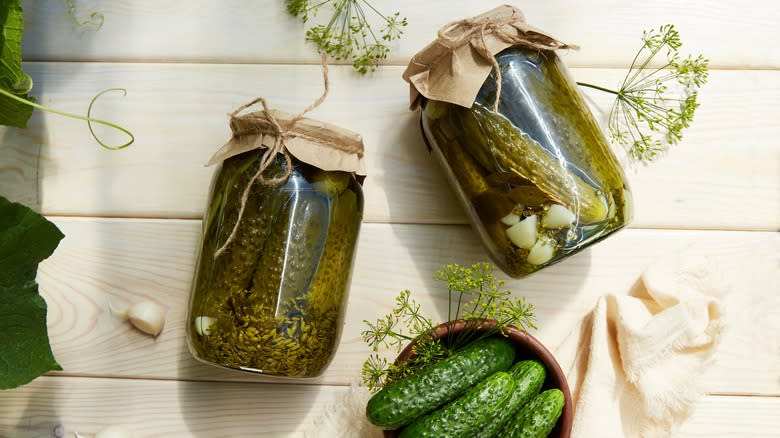Amp Up The Umami Of Your Next Pickle Brine With A Sprinkle Of MSG

Although cucumbers are the quintessential pickled food, just about anything can be pickled with the right brine. From red onions steeped in garlicky vinegar to okra saturated in a spicy marinade, there are a million and one ways to pickle produce. And it doesn't stop there: Pickle brine can be used to marinate meat, tofu, and vegetables before they get seared, grilled, broiled, or baked. Long story short, pickle brine is a culinary secret weapon. Part of what makes pickle brine so special is that it can be customized to fit your unique tastes and preferences, and if you're anything like us, an umami flavor profile is one of the best ways to elevate any dish. Enter MSG.
MSG is a naturally occurring derivative of an amino acid found in various foods like tomatoes and cheese. Revered for its strong umami essence, introducing MSG to your favorite pickle brine gives the solution a savory, slightly meaty quality that's robust and hearty. Not only does MSG deliver rich umami notes to the center of your brine, but it also highlights the other flavors in the solution, giving each bite a dynamic and full-bodied taste.
Read more: French Cooking Tricks You Need In Your Life
MSG Fast Facts And Tips

Although many myths surround MSG and its nutritional value, the United States Food & Drug Administration recognizes MSG as "generally safe." MSG possesses only one-third of the amount of sodium found in other flavor enhancers like table salt, which means that using MSG in your cooking in place of salt can lower your sodium intake, a dietary practice that the United States Department of Health and Human Services says is proven to improve heart health. While there have been reports of MSG triggering headaches and other unpleasant symptoms, there is no scientific evidence that supports these claims.
When it comes to flavor intensity, MSG packs a hefty punch, so be mindful of how much you include in the pickle brine. If you're not sure how much MSG to add to your brine, start by adding a small pinch and tasting as you go to ensure that you have a well-balanced tapestry of flavors that teeter between zesty, refreshing, and savory.
Uses And Complementary Ingredients

MSG pickle brines can be used in a wide range of recipes, but if you don't know where to start, we've got you covered on some recommendations for putting your new and improved, ultra-savory brine to good use.
MSG pickle brines will impart a hearty depth to classic cucumber pickles, pickled red onions, and pickled potatoes to boot, but don't limit yourself -- think beyond traditional pickling. Consider marinating a cut of steak or chicken in your MSG-rich brine before grilling, pan-searing, or deep frying it to strengthen the umami flavor that's naturally present in the meat. If you enjoy the flavors of meat, but follow a plant-based diet, marinating tofu or vegetables in MSG is a great way to achieve a meaty taste without any animal products.
Remember that MSG is a flavor enhancer, so experimenting with additional ingredients is an easy way to develop a more complex taste in your pickle brine. Adding fresh herbs like dill, thyme, or rosemary, as well as incorporating a hint of spice with red pepper flakes or sliced jalapeños, elevates the savory goodness of the pickle brine by introducing additional layers of flavor. Each herb contributes its unique aromatic notes, enhancing the overall complexity of the brine. Dill brings a refreshing and tangy flavor, thyme adds earthiness, rosemary imparts a pine-like essence, and peppers bring a touch of fire to the mix -- all amplified by a delicate inclusion of MSG.
Read the original article on Daily Meal.


